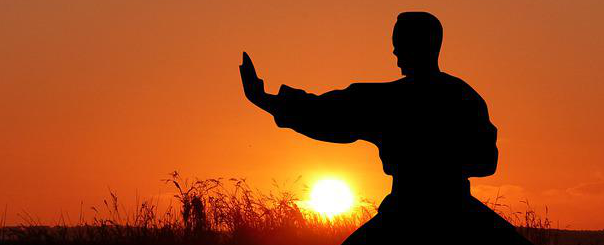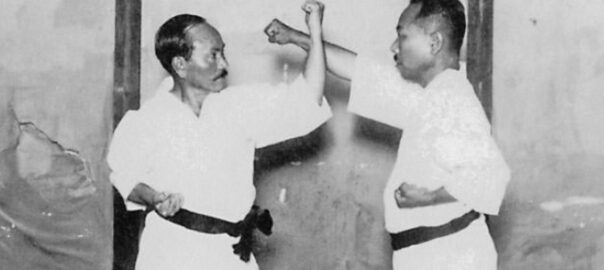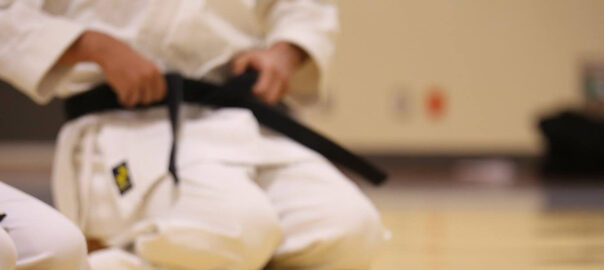Learn what pioneers like Funakoshi Gichin, Mabuni Kenwa and Motobu Choki thought about the practical applications of karate kata, bunkai, throws and joint locks. Their words paint a picture very different from modern sports Karate.
Quotes
We must avoid treating Karate as a sport. Your fingers and toes must be like arrows, your arms must be like iron. If you kick, try to kick the enemy dead. If you punch, punch to kill. This is the spirit you need to progress in karate.
Chibana Chōshin (1885-1969)
Once a kata has been learned, it must be practiced repeatedly until it can be applied in an emergency. Knowledge or just the sequence of a form in karate is useless.
Gichin Funakoshi (1868-1957)
We should open karate to the public and receive criticism, opinions and studies from other prominent fighting artists.
Chojun Miyagi (1888-1953)
The techniques of kata have their limits and were never intended to be used against an opponent in the arena or battlefield.
Choki Motobu (1870-1944)
The karate that has spread to Tokyo is incomplete. Those who believe that karate consists only kicks and punches, and think throws and joint locks are exclusive to judo or jujutsu, have been misinformed. We should have an open mind and strive to study the complete art.
Kenwa Mabuni (1889-1952)
My old ways of karate was not accepted by everyone. Maybe my training methods were too hard or severe. Whatever it was, it was the way I learned and thaught. It was only later, when the Americans came, that I changed my ways.
Hohan Sōken (1889-1982)
There is no place in karate for differen styles, I’ve heard myself and colleagues refferred to as the “Shotokan” school, but I strongly object this attempt at classification. My belief is that all styles should be amalgamated into one, so karate my orderly progress into man’s future.
Gichin Funakoshi (1868-1957)
It is necessary to drink alcohol and pursue other fun human activities. The karate of someone who is too serious has no flavor.
Choki Motobu (1870-1944)
Kata must be practised diligently, but you must not be constrained by them. You must withdraw from the kata to produce forms with no limits, or else it becomes useless.
Hironori Otsuka (1892-1982)
Karate does not have any styles. It molds an individual to be the object of defense or offense and, through this process, karate teaches you the fundamental concept of self protection.
Kanken Toyama (1888-1966)
A kata is not fixed or immoveable. Like water, it’s ever changing and fits itself to the shape of the vessel containing it. However, kata is not some kind of beautiful competitive dance, but a grand matrial art of self-defense, which determines life and death.
Kenwa Mabuni (1889-1952)
Karate was never meant to be used against a single opponent. Rather, it’s a method of avoiding injury by using the hands and feet, should one happen to be confronted by a vilian or a thug.
Anko Itosu (1831-1915)
You may train for a long time, but if you merely move your limbs and jump around like a puppet, learning karate is not very different from learning a dance. You will never have reached the heart of the matter; you will have failed to grasp the quintessence of Karate.
Gichin Funakoshi (1868-1957)
Nothing is more harmful to the world than a martial art that is not effective in actual self-defense.
Choki Motobu (1870-1944)
Karate has no philosophy. Some people think it came from the Buddhism and has a connection with the space and universe, but I don’t belive in that. My philosophy is to knock my opponent out with a single blow!
Mikio Yahara (1947)
Do not fall into the trap of thinking that just because a kata begins to the left, the opponents ist attacking form the left.
Kenwa Mabuni (1889-1952)
In the past, roughly three years were required to learn a single kata, and usually an expert of considerable skill would only know three, or at most five katas.
Gichin Funakoshi (1868-1957)
Techniques should not be practised merely so they can be performed in a kata. Since karate is a fighting art, each technique has its meaning. You must consider their meaning, how and why they are effective, and practise accordingly.
shigeru egami (1912-1981)
Many karate instructors today teach a watered down style – no hip and shallow punching. It’s easy to say that these teachers have no dept to their knowledge.
Yuchoku Higa (1910-1994)
There are many kinds of postures in karate. While learning these postures should not be totally ignored, we must be careful not to overlook that they are just forms or templates. It is the function of their application which needs to be mastered.
Choki Motobu (1870-1944)
Punching, striking and kicking are not the only methods in karate. Throwing techniques and submissions holds are included. All these techniques should be studied in basic kata.
Gichin Funakoshi (1868-1957)
Regardless of how many kata you know, if your training is inadequate they will be useless.
Kenwa Mabuni (1889-1952)
The Karate Masters














